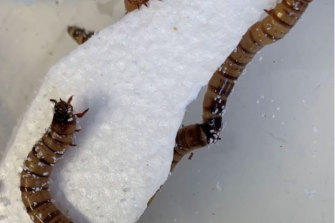The ‘superworms’ that might save us from plastic pollution
By Stuart Layt
Scientists have discovered that a certain type of “superworm” can actually eat plastic, pointing the way to a possible solution for the problem of plastic waste.
The “worms” are actually the larvae of Zophobas morio, a type of darkling beetle, and are closely related to another species, Tenebrio molitor, whose larvae are commonly called mealworms.

UQ researchers have discovered superworms (pictured) can eat styrofoam, giving clues about an innovative solution to plastic waste.
Mealworms and superworms are both used extensively in the pet food industry, and in some parts of the world are eaten by humans as well.
But scientists from the University of Queensland have discovered what the superworms themselves can eat that is truly interesting.
Dr Chris Rinke and his team from UQ’s School of Chemistry and Molecular Biosciences said it had been shown previously that mealworms can eat polystyrene, and appeared to not only suffer no ill effects but actually got nutrients from the plastic.
Rinke said they wanted to see if superworms could also survive on a diet of plastic, and found that they could.
“Mealworms are fairly small, about 1-2 centimetres, we wondered if the large superworms could also digest plastic, and maybe more efficiently,” he said.
Despite the fact that the superworms can eat the plastic, it does not mean that they will eat plastic, and they do not regularly eat plastic in the wild.
However, Rinke said when all they have to eat is plastic, they will tuck in without any seeming ill effects.
Using metagenomics, the researchers discovered the superworms were able to do this because of a group of enzymes in their gut which helps to break down the plastic.
It is these enzymes which interest the scientists, Rinke said, because if they can reverse-engineer them they could develop a substance which dissolves plastic waste.
“The worms shred and swallow the plastic but it’s the microbes in their gut which are actually digesting the plastic, and that’s what we now want to focus on,” he said.
Despite recent research by CSIRO suggesting Australia’s coastal plastic pollution has decreased by 29 per cent since 2013, the country still produces 2.5 million tonnes of plastic waste each year, much of which ends up in waterways and the ocean.
Rinke said while it would still take them several years to extrapolate the enzymes they’ve identified into something that could be useful, he believed it could eventually be produced at a scale that could help deal with plastic waste.
“The idea is to really collect those enzymes, find out under which conditions they work, which ones are the best ones, whether they can be improved further,” he said.
“We plan to work on this over the next three-to-four years, and after that we hope to have a group of enzymes which would be very useful for such an approach.”
As an added benefit, the waste produced when the superworms digest the plastic appears to itself be able to be broken down further to create high-value compounds such as bioplastics, which could then be reused.
The research has been published in the journal Microbial Genomics.